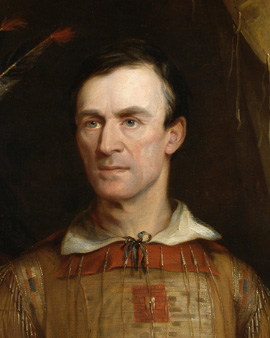At the end of the 19th century, the USA stood for the dawn of modernity. Industrialisation and capitalism shaped the new dynamic world power and made it the land of unlimited opportunities for Europeans. At the same time, the United States also brought forth a tradition of criticism of civilization, for which Henry David Thoreau and his novel "Walden" are representative. Thoreau sang the song of praise to the simple life, against the urban world of modernity. George Catlin stands in this tradition. The conquest of the West took place in the fight against the indigenous people of the continent. The cultures of the Native American peoples perished in the treks of settlers and the rifles of the US cavalry. Catlin is the most outstanding chronicler of the Native American's disappearing world. His reports, books and above all sketches and paintings are today an important part of the cultural heritage of the USA.
Catlin came into contact with the Indian culture early on. His mother and grandmother were kidnapped by Indians before his birth and used as hostages. In the rural Midwest, Catlin grew up in a close relationship with nature and began to collect Indian cult objects. But his father had other plans for the boy and sent him to the city to study law. Catlin completed law school and practiced as a lawyer. During this time, the desire grew in him to combine his love of nature and his artistic inclinations and to work as a painter. After first years as a portrait painter in New York, he finally found his way back to the interests of his youth and discovered Indian culture as the subject of his works. After first portrait studies of Indian delegates, he set out to study Indian culture in its natural habitat. Today Catlin is considered the expert on the "true" Indian life. His travelogues and portraits are today part of the cultural heritage of the USA and an invaluable source for research on the Native Americans.
Trips to the different Indian tribes followed. As a connoisseur of Indian culture, Catlin also accompanied official missions for first contact, e.g. with the Comanches in 1834. Catlin became increasingly fascinated by the culture of the Native Americans and protested against their ruthless colonization. From 1837 Catlin presented the culture of the Native Americans to a larger audience in his Indian Gallery, which reacted with fascination to the unknown world. After the success in America, Catlin also travelled to Europe with his exhibition. In 1845 Catlin began to show Indian rituals publicly, first by whites and then by Indians. The interest in this declining culture was so great that he also showed these cultural events in London and Paris. Due to personal strokes of fate, he left North America and tried his hand at gold prospecting in South America before settling in Brussels. Only at an advanced age did he return to the USA.
×





.jpg)
.jpg)
.jpg)
.jpg)
.jpg)
.jpg)
.jpg)
.jpg)
.jpg)
.jpg)
.jpg)
.jpg)
_-_(MeisterDrucke-1090016).jpg)
_-_(MeisterDrucke-1090016).jpg)
.jpg)
.jpg)
.jpg)
.jpg)
.jpg)
.jpg)
.jpg)
.jpg)
_-_(MeisterDrucke-1083560).jpg)
_-_(MeisterDrucke-1083560).jpg)
.jpg)
.jpg)
.jpg)
.jpg)
.jpg)
.jpg)
.jpg)
.jpg)
.jpg)
.jpg)
.jpg)
.jpg)
.jpg)
.jpg)
.jpg)
.jpg)
.jpg)
.jpg)
.jpg)
.jpg)
.jpg)
.jpg)
.jpg)
.jpg)
.jpg)
.jpg)
.jpg)
.jpg)
.jpg)
.jpg)
.jpg)
.jpg)
.jpg)
.jpg)
.jpg)
.jpg)
.jpg)
.jpg)
_-_(MeisterDrucke-1087589).jpg)
_-_(MeisterDrucke-1087589).jpg)
.jpg)
.jpg)
.jpg)
.jpg)
.jpg)
.jpg)
.jpg)
.jpg)
.jpg)
.jpg)
.jpg)
.jpg)
.jpg)
.jpg)
.jpg)
.jpg)
.jpg)
.jpg)
.jpg)
.jpg)
.jpg)
.jpg)
_-_(MeisterDrucke-1661884).jpg)
_-_(MeisterDrucke-1661884).jpg)
.jpg)
.jpg)
.jpg)
.jpg)
.jpg)
.jpg)
.jpg)
.jpg)
_-_(MeisterDrucke-1083566).jpg)
_-_(MeisterDrucke-1083566).jpg)
.jpg)
.jpg)
.jpg)
.jpg)
.jpg)
.jpg)
.jpg)
.jpg)
.jpg)
.jpg)
.jpg)
.jpg)
.jpg)
.jpg)
.jpg)
.jpg)
.jpg)
.jpg)
.jpg)
.jpg)
.jpg)
.jpg)
.jpg)
.jpg)
.jpg)
.jpg)
.jpg)
.jpg)
.jpg)
.jpg)
.jpg)
.jpg)
.jpg)
.jpg)
.jpg)
.jpg)
.jpg)
.jpg)
.jpg)
.jpg)
.jpg)
.jpg)
.jpg)
.jpg)
.jpg)
.jpg)
.jpg)
.jpg)
.jpg)
.jpg)
.jpg)
.jpg)
.jpg)
.jpg)
.jpg)
.jpg)
.jpg)
.jpg)
.jpg)
.jpg)
.jpg)
.jpg)
.jpg)
.jpg)
.jpg)
.jpg)
.jpg)
.jpg)
.jpg)
.jpg)
.jpg)
.jpg)
.jpg)
.jpg)
.jpg)
.jpg)
.jpg)
.jpg)
.jpg)
.jpg)
.jpg)
.jpg)
.jpg)
.jpg)
.jpg)
.jpg)
.jpg)
.jpg)
.jpg)
.jpg)
.jpg)
.jpg)
.jpg)
.jpg)
.jpg)
.jpg)
.jpg)
.jpg)
.jpg)
.jpg)
.jpg)
.jpg)






